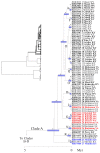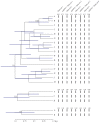Multilocus Phylogeography and Species Delimitation in the Cumberland Plateau Salamander, Plethodon kentucki: Incongruence among Data Sets and Methods
- PMID: 26974148
- PMCID: PMC4790894
- DOI: 10.1371/journal.pone.0150022
Multilocus Phylogeography and Species Delimitation in the Cumberland Plateau Salamander, Plethodon kentucki: Incongruence among Data Sets and Methods
Abstract
Species are a fundamental unit of biodiversity, yet can be challenging to delimit objectively. This is particularly true of species complexes characterized by high levels of population genetic structure, hybridization between genetic groups, isolation by distance, and limited phenotypic variation. Previous work on the Cumberland Plateau Salamander, Plethodon kentucki, suggested that it might constitute a species complex despite occupying a relatively small geographic range. To examine this hypothesis, we sampled 135 individuals from 43 populations, and used four mitochondrial loci and five nuclear loci (5693 base pairs) to quantify phylogeographic structure and probe for cryptic species diversity. Rates of evolution for each locus were inferred using the multidistribute package, and time calibrated gene trees and species trees were inferred using BEAST 2 and *BEAST 2, respectively. Because the parameter space relevant for species delimitation is large and complex, and all methods make simplifying assumptions that may lead them to fail, we conducted an array of analyses. Our assumption was that strongly supported species would be congruent across methods. Putative species were first delimited using a Bayesian implementation of the GMYC model (bGMYC), Geneland, and Brownie. We then validated these species using the genealogical sorting index and BPP. We found substantial phylogeographic diversity using mtDNA, including four divergent clades and an inferred common ancestor at 14.9 myr (95% HPD: 10.8-19.7 myr). By contrast, this diversity was not corroborated by nuclear sequence data, which exhibited low levels of variation and weak phylogeographic structure. Species trees estimated a far younger root than did the mtDNA data, closer to 1.0 myr old. Mutually exclusive putative species were identified by the different approaches. Possible causes of data set discordance, and the problem of species delimitation in complexes with high levels of population structure and introgressive hybridization, are discussed.
Conflict of interest statement
Figures








Similar articles
-
Phylogeographic analysis of mitochondrial gene flow and introgression in the salamander, Plethodon shermani.Mol Ecol. 2005 Apr;14(5):1457-72. doi: 10.1111/j.1365-294X.2005.02524.x. Mol Ecol. 2005. PMID: 15813784
-
An integrative approach to phylogeography: investigating the effects of ancient seaways, climate, and historical geology on multi-locus phylogeographic boundaries of the Arboreal Salamander (Aneides lugubris).BMC Evol Biol. 2015 Nov 4;15:241. doi: 10.1186/s12862-015-0524-9. BMC Evol Biol. 2015. PMID: 26537350 Free PMC article.
-
What are the consequences of combining nuclear and mitochondrial data for phylogenetic analysis? Lessons from Plethodon salamanders and 13 other vertebrate clades.BMC Evol Biol. 2011 Oct 13;11:300. doi: 10.1186/1471-2148-11-300. BMC Evol Biol. 2011. PMID: 21995558 Free PMC article.
-
Assessing species boundaries using multilocus species delimitation in a morphologically conserved group of neotropical freshwater fishes, the Poecilia sphenops species complex (Poeciliidae).PLoS One. 2015 Apr 7;10(4):e0121139. doi: 10.1371/journal.pone.0121139. eCollection 2015. PLoS One. 2015. PMID: 25849959 Free PMC article.
-
How to fail at species delimitation.Mol Ecol. 2013 Sep;22(17):4369-83. doi: 10.1111/mec.12413. Epub 2013 Jul 16. Mol Ecol. 2013. PMID: 23855767 Review.
Cited by
-
Transcriptome analysis of two radiated Cycas species and the subsequent species delimitation of the Cycas taiwaniana complex.Appl Plant Sci. 2019 Oct 16;7(10):e11292. doi: 10.1002/aps3.11292. eCollection 2019 Oct. Appl Plant Sci. 2019. PMID: 31667020 Free PMC article.
-
One species or four? Yes!...and, no. Or, arbitrary assignment of lineages to species obscures the diversification processes of Neotropical fishes.PLoS One. 2017 Feb 24;12(2):e0172349. doi: 10.1371/journal.pone.0172349. eCollection 2017. PLoS One. 2017. PMID: 28235096 Free PMC article.
-
Markers for genetic change.Heliyon. 2021 Jan 2;7(1):e05583. doi: 10.1016/j.heliyon.2020.e05583. eCollection 2021 Jan. Heliyon. 2021. PMID: 33437884 Free PMC article.
References
-
- Sites JW, Marshall JC. Delimiting species: a renaissance issue in systematic biology. Trends Ecol Evol. 2003; 18: 462–470. 10.1016/S0169-5347(03)00184-8 - DOI
-
- Sites JW, Marshall JC. Operational criteria for delimiting species. Ann Rev Ecol Evol Syst. 2004; 35: 199–227. 10.1146/annurev.ecolsys.35.112202.130128 - DOI
-
- Kuchta S, Wake DB. Wherefore and wither the ring species? Copeia 2016; In press.
-
- Camargo A, Sites JW. Species delimitation: a decade after the renaissance In: Pavlinov IY, editor. The Species Problem: Ongoing Issues. InTech—Open Access publisher, Rijeka, Croatia; 2013. 10.5772/52664 - DOI
MeSH terms
Substances
LinkOut - more resources
Full Text Sources
Other Literature Sources

